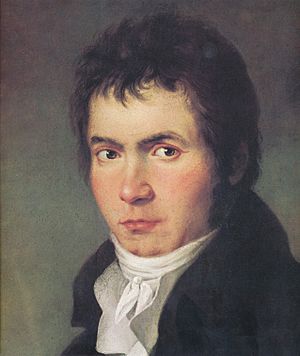Symphony No. 3 "Eroica" (Beethoven) facts for kids
The Symphony No. 3 in E flat major, often called the "Eroica" Symphony, is a famous piece of music for an orchestra. It was written by Ludwig van Beethoven in 1803 and finished in 1804. The word "Eroica" means "Heroic" in Italian, and that's how the symphony was published in 1806.
The symphony was first performed on April 7, 1805, at the Theater an der Wien. Beethoven originally wanted to dedicate this symphony to Napoleon Bonaparte, who he saw as a hero. However, when Napoleon declared himself Emperor, Beethoven was very upset. He felt Napoleon had betrayed his ideals, so he tore up the dedication page.
Contents
What is a Symphony?
A symphony is a long piece of music, usually for a large orchestra. It is often divided into several main parts called movements. The "Eroica" Symphony has four movements. Each movement has its own mood and speed, called tempo.
The Movements
First Movement: Allegro con brio
This movement is fast and lively. It starts with two strong E-flat major chords. Then, the main melody is played by the cellos. Later, a second main melody appears. This movement uses a structure called Sonata form, which is a common way to organize music.
Second Movement: Marcia funebre. Allegro assai
This movement is a slow and serious funeral march. It has a very emotional and sad feeling.
Third Movement: Scherzo. Allegro vivace - Trio
This movement is fast and playful. "Scherzo" means "joke" in Italian. It has a middle section called the "Trio" which offers a contrast before returning to the main scherzo part.
Fourth Movement: Finale. Allegro molto - Poco Adante - Presto
The last movement is very energetic and exciting. It starts fast, slows down a bit, and then ends with a very quick and powerful finish.


